With the EN7600GS TOP (test), Asus reached into the gap between the GeForce 7600 GS and GT in July 2006: With passive cooling, powerful overclocking and 512 MB graphics memory, the equipment was attractive for many gamers .
Table of contents
- 1 More clock and memory than the reference design
- 25 euros more expensive for up to 34 percent more performance
- Conclusion
More clock and memory than the reference design
Both the GeForce 7600 GS and the GT rely on Nvidia's G73 GPU. The differences were that the GPU on the GT version was operated at 560 instead of 400 MHz and that the memory was of the GDDR3 type instead of DDR2 and was accordingly clocked higher. The Asus EN7600GS TOP Silent was closer to the GeForce 7600 GT in terms of GPU performance due to its speed of 550 MHz, but the DDR2 graphics memory was only marginally faster than the one on the GeForce 7600 GS at 475 MHz. With a capacity of 512 MB, the graphics memory of the EN7600 GS TOP stood out from both reference designs.
per pipeline (MADD) 2 FLOPs (MADD/ADD) 77 GFLOPS 106 GFLOPS 108 GFLOPS ROPs 8 pixel fill rate 3,200 MPix/s 4,400 MPix/s 4,480 MPix/s TMUs per pixel pipeline 1 texel fill rate 4,800 MTex/s 6,600 MTex/s 6,720 MTex/s vertex shader 5 triangular throughput 500 MV/s 688 MV/s 700 MV/s pixel shader PS 3.0 vertex shader VS 3.0 memory size 256 MB DDR2 512 MB DDR2 256 MB GDDR3 memory clock 400 MHz 475 MHz 700 MHz memory interface 128 bit memory bandwidth 12,800 MByte/s 15,200 MByte/s 22,400 MByte/s SLI/CF support Yes
There were only a few capacitors and a comparatively small heat sink on the front of the graphics card. The reason: In order to be able to use the airflow of the CPU cooler, Asus placed the GPU together with the large passive cooler on the back of the graphics card. The cooler itself was made of aluminum, an embedded copper block transported the waste heat from the GPU to the fins with the help of a heat pipe. Using a swivel arm, the heat sink could be swiveled upwards by 90 ° so that the cooler could be better positioned in the airflow.
-
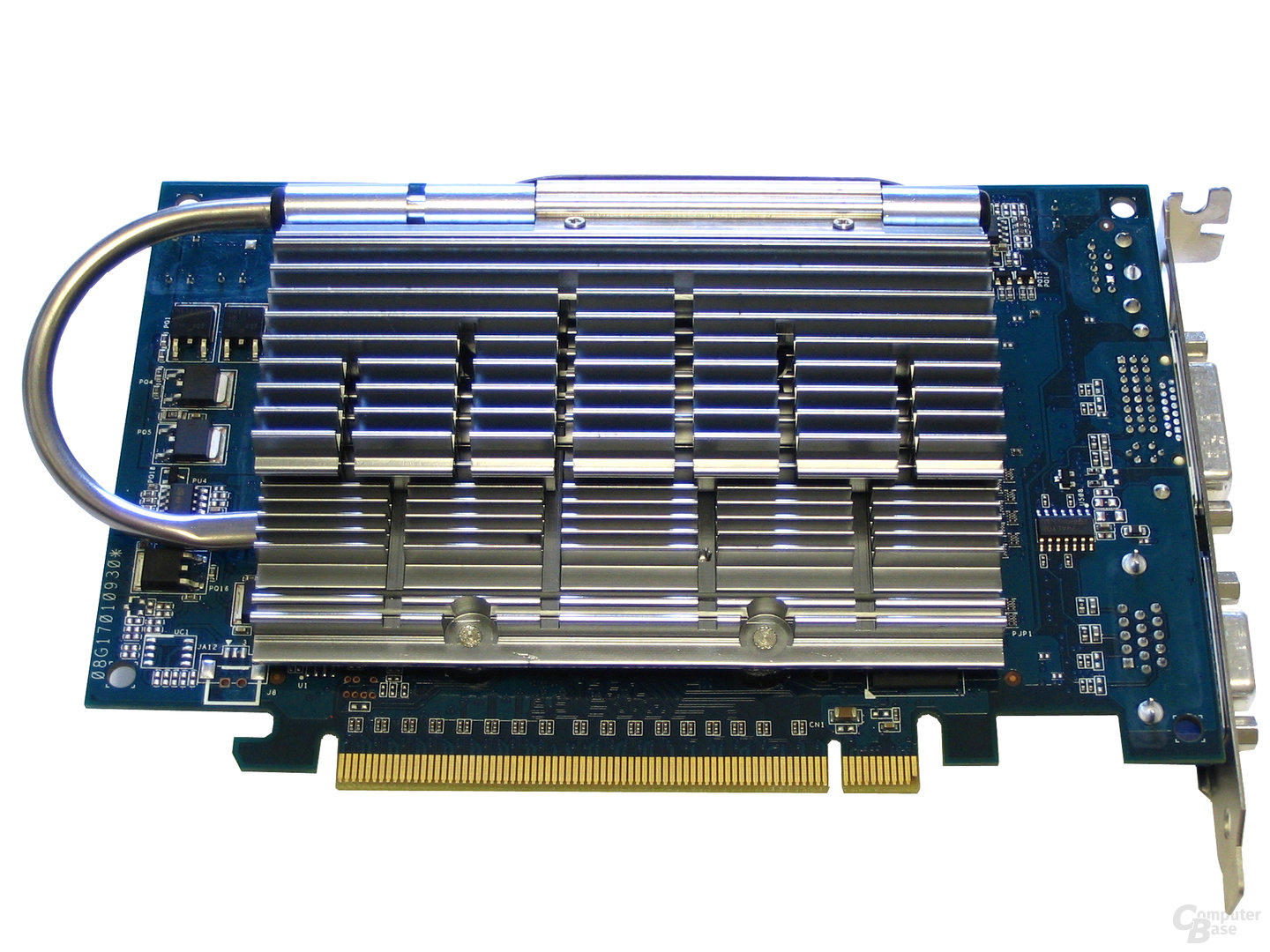 EN7600GS TOP Silent back
EN7600GS TOP Silent back
Image 1 of 9
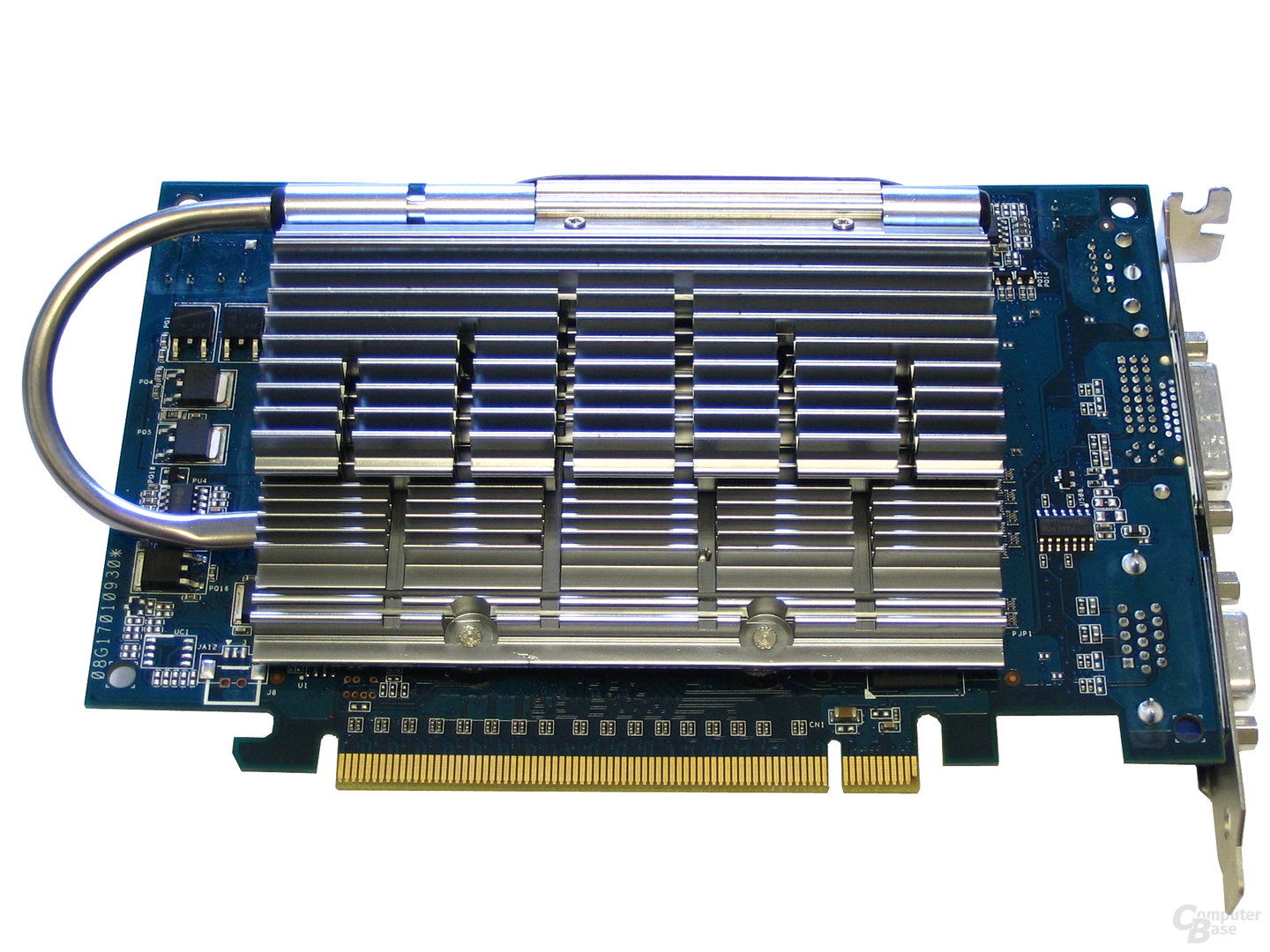 EN7600GS TOP Silent backside
EN7600GS TOP Silent backside 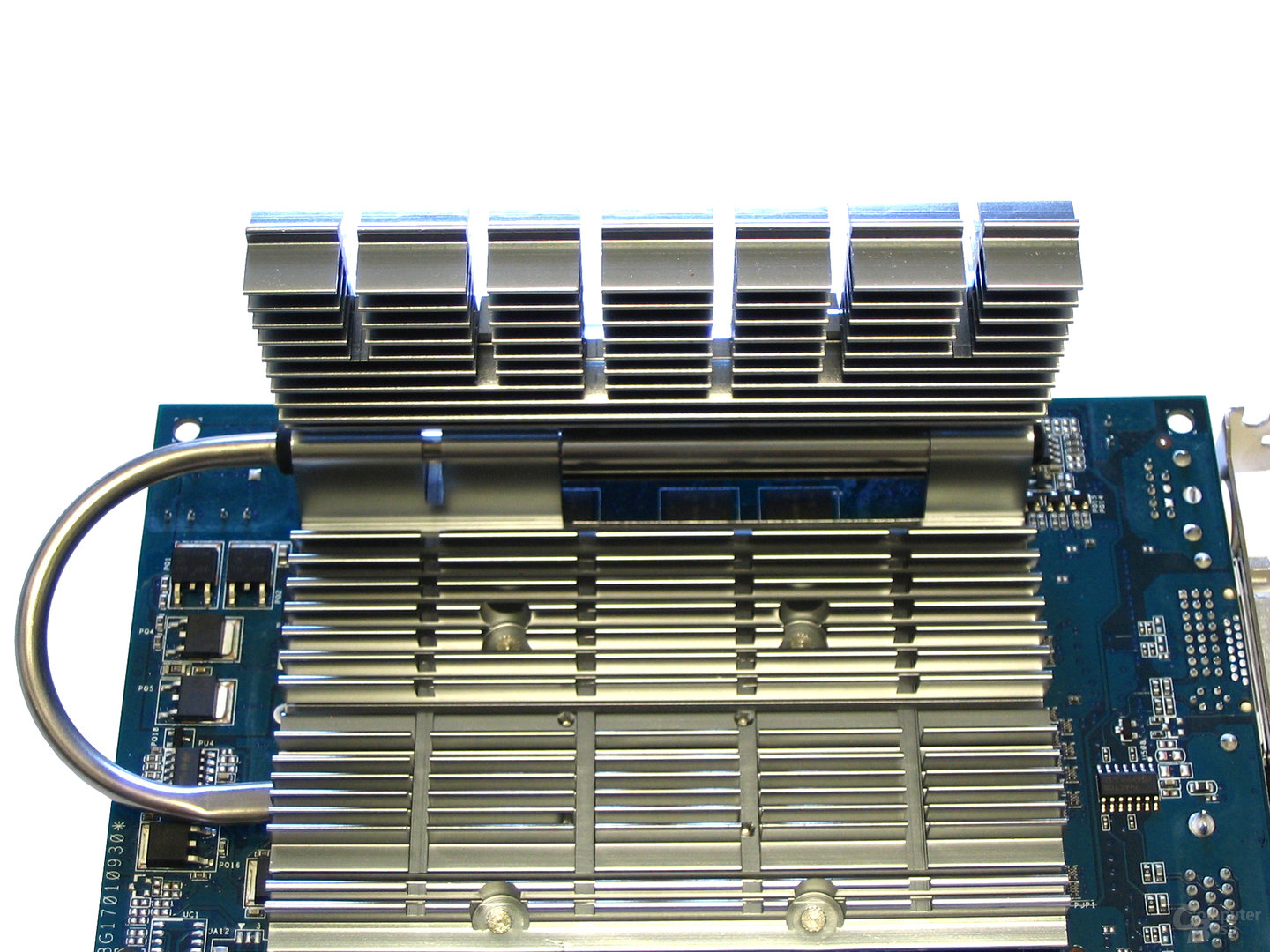 En7600GS TOP Silent with swivel arm
En7600GS TOP Silent with swivel arm  Asus logo
Asus logo 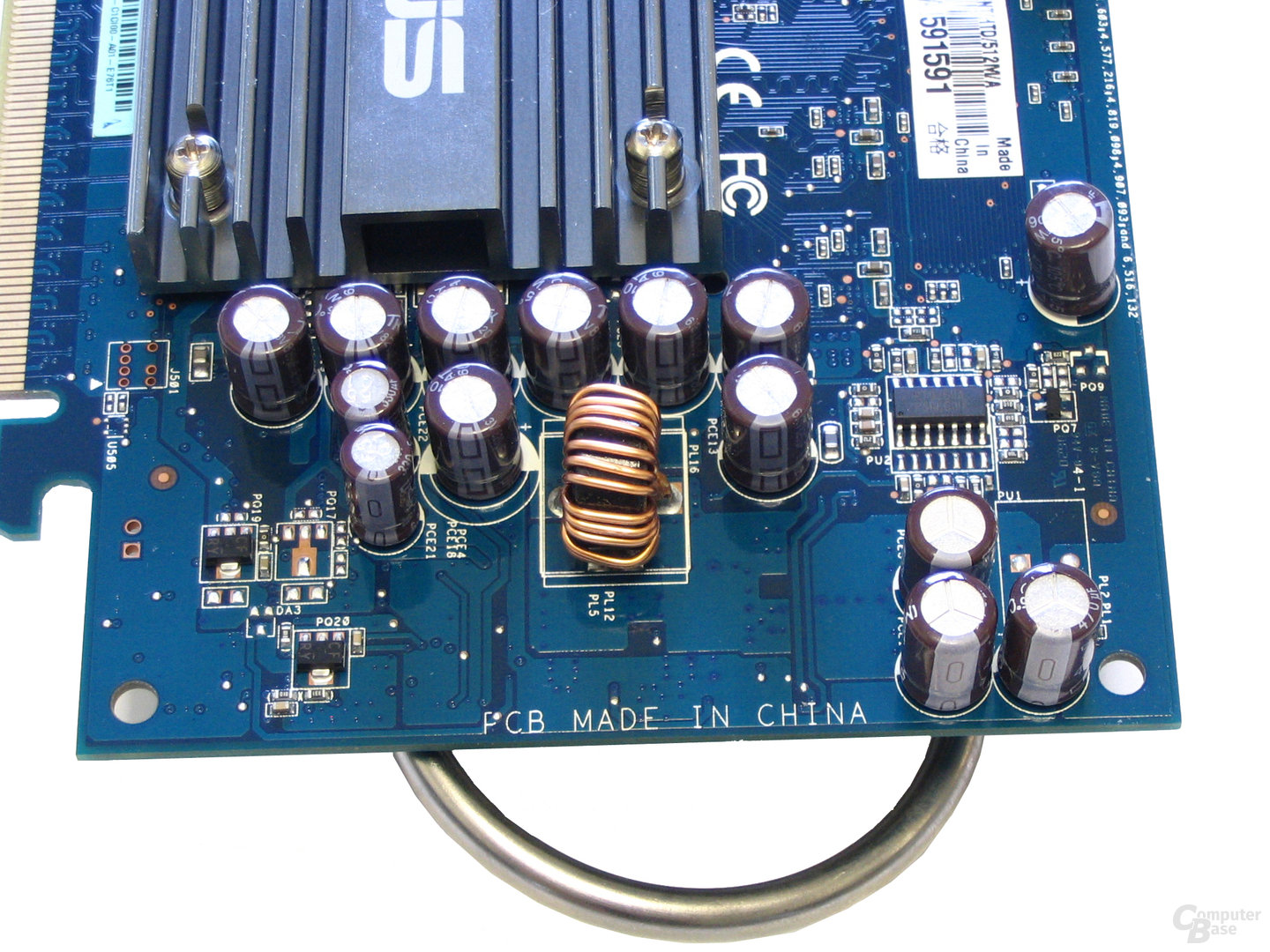 EN7600GS TOP Silent Heatpipe
EN7600GS TOP Silent Heatpipe 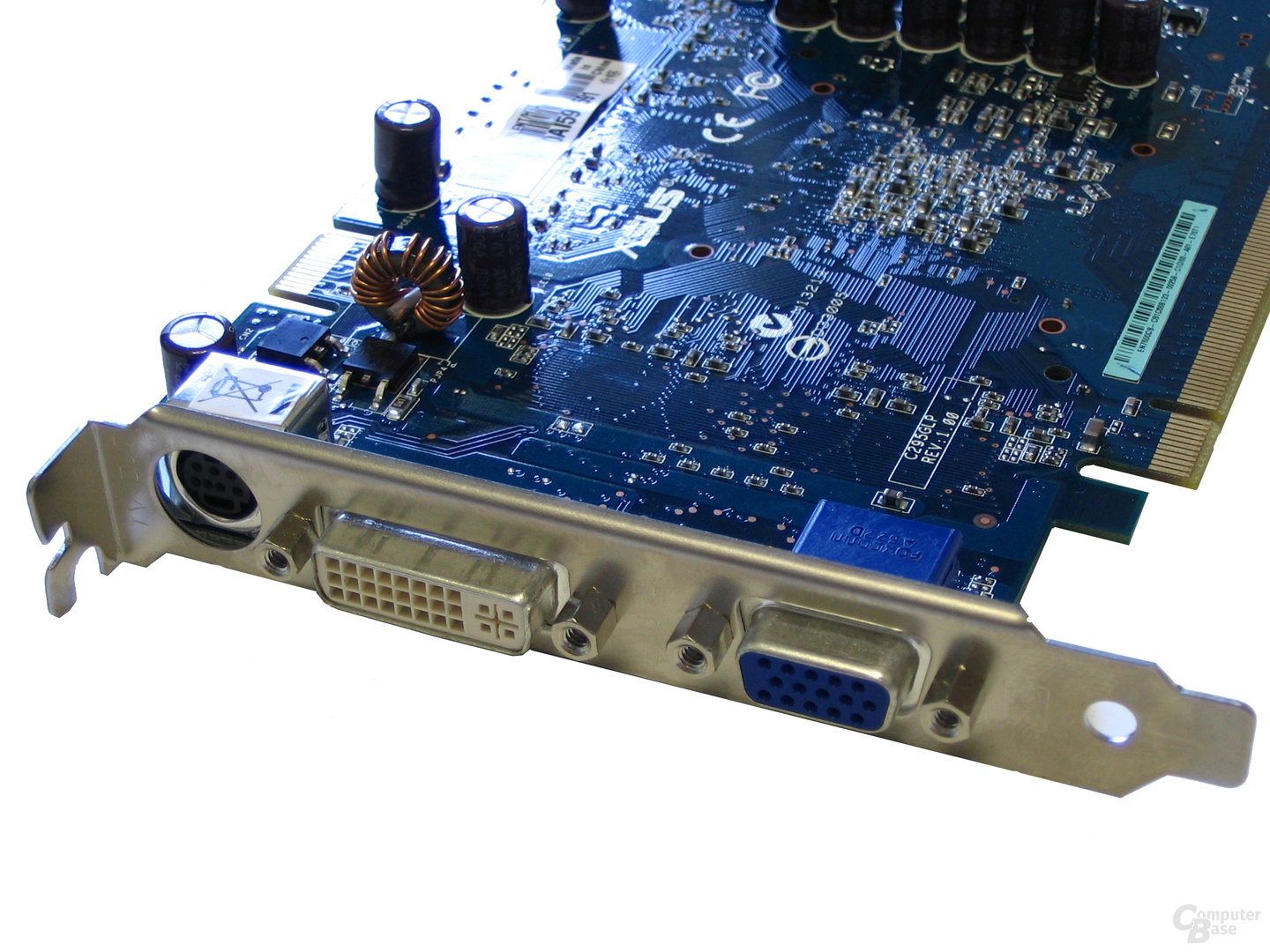 EN7600GS TOP Silent slot bracket
EN7600GS TOP Silent slot bracket 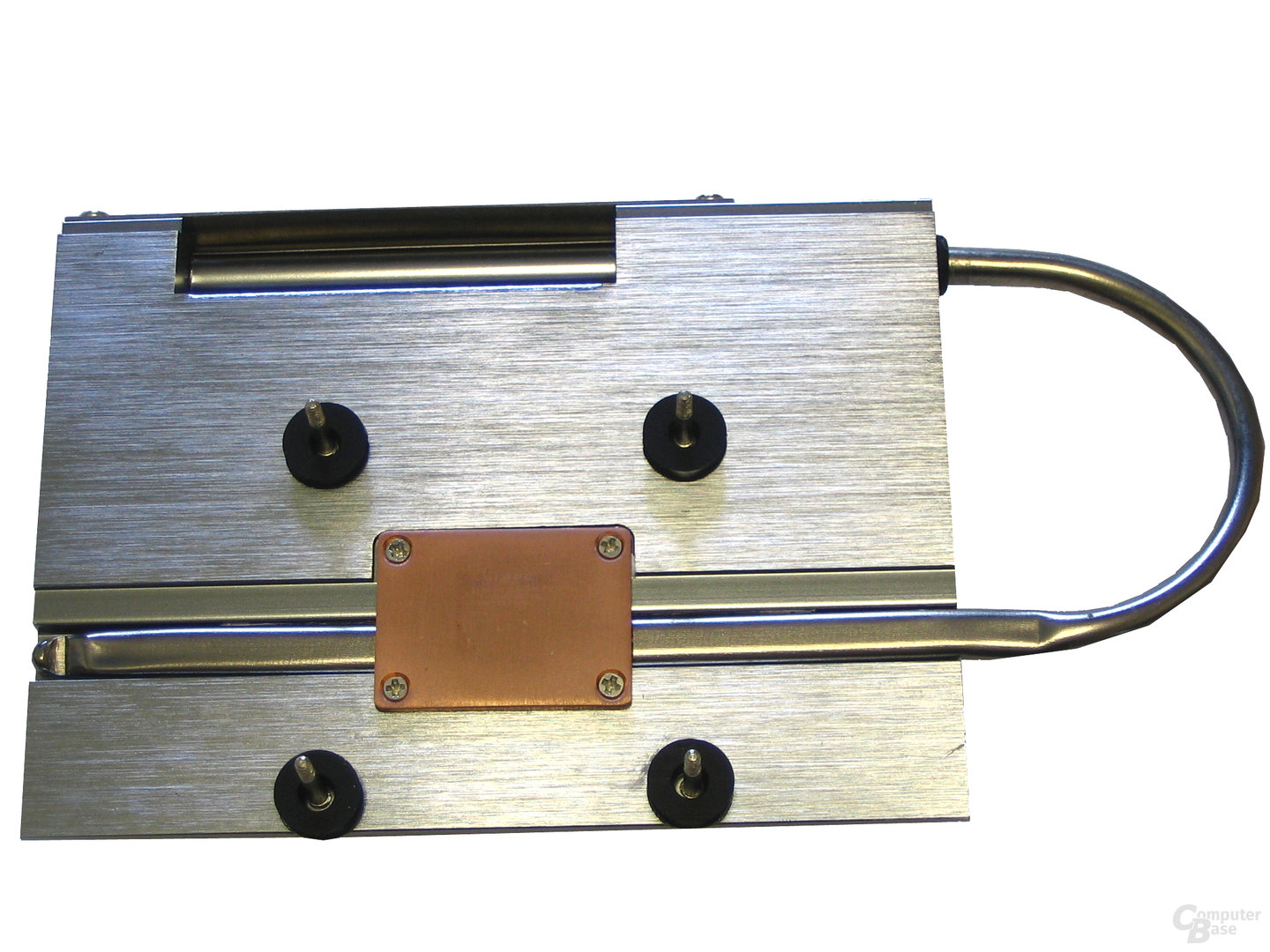 EN7600GT TOP Silent Kuehlerrueckseite
EN7600GT TOP Silent Kuehlerrueckseite 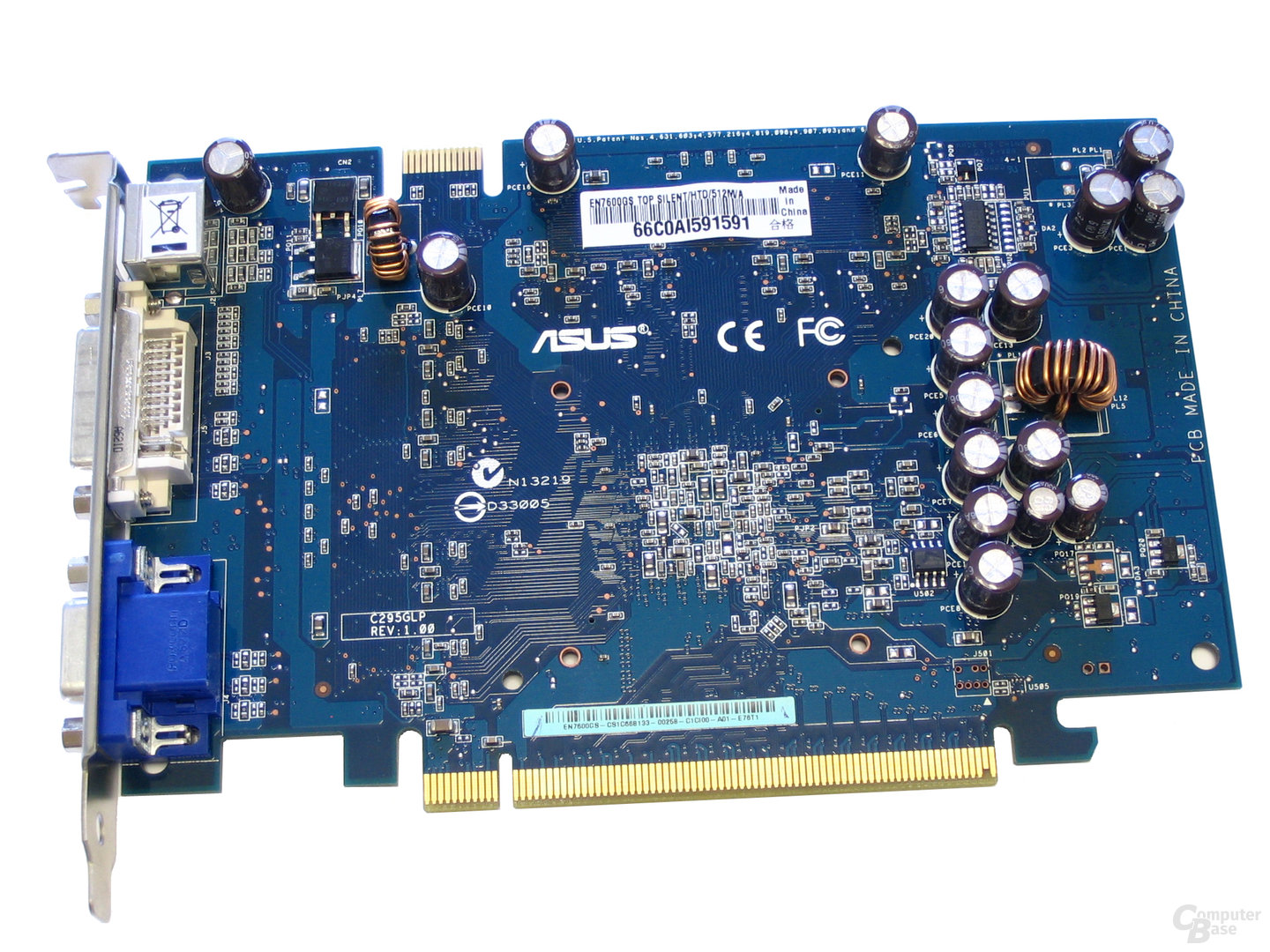 EN7600GT TOP Silent figure without Kuehler7600 img src = “/wp-content/uploads/8dd2186c35eea557840745b835867d2f.jpg” />EN7600GS TOP Silent back without cooler
EN7600GT TOP Silent figure without Kuehler7600 img src = “/wp-content/uploads/8dd2186c35eea557840745b835867d2f.jpg” />EN7600GS TOP Silent back without cooler 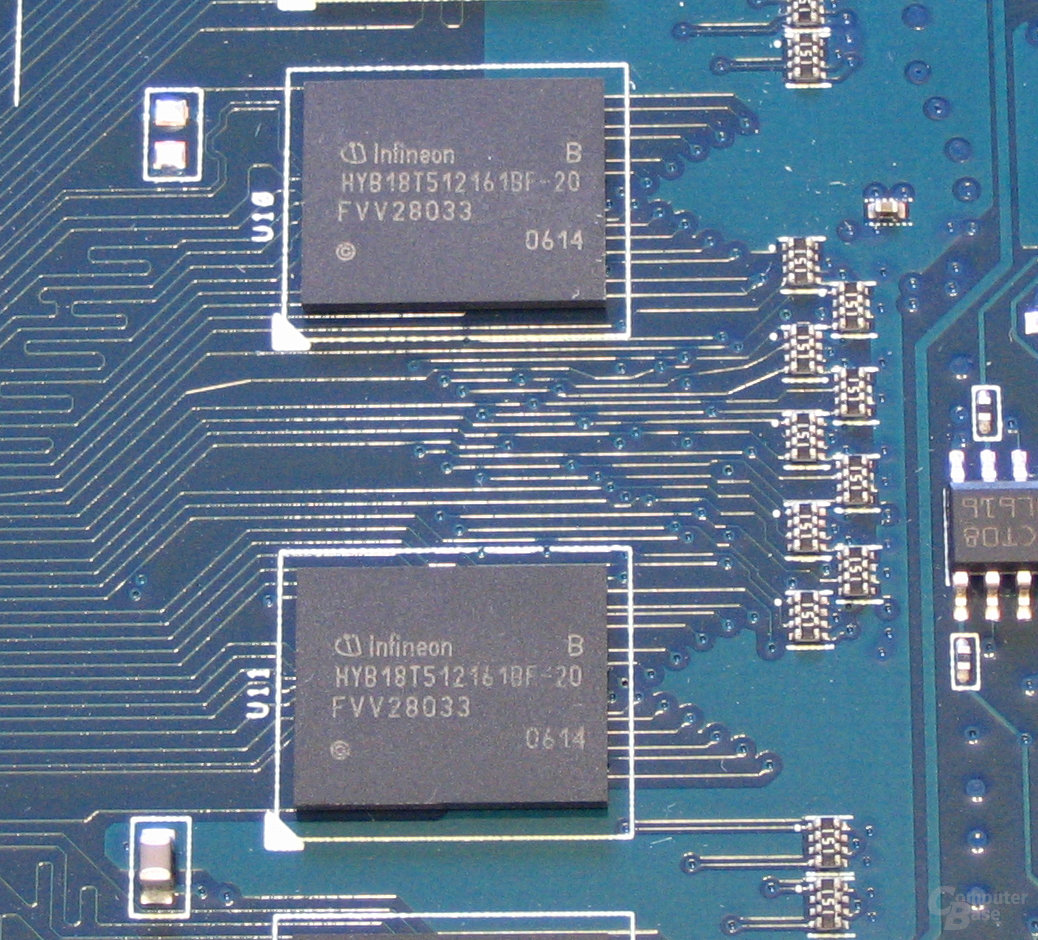 Infineon-RAM 2.0 ns
Infineon-RAM 2.0 ns 25 euros more expensive for up to 34 percent more performance
With a price of 130 euros, the Asus EN7600GS TOP Silent was an inexpensive graphics card; compared to the reference design from Nvidia, the surcharge was around 25 euros. In return, customers could expect significantly more performance. In the benchmarks with an Athlon 64 FX-60 and 2 × 1,024 MB Corsair TwinX1024-3500LL PRO (2-3-2-5), the speed advantages were considerable. Without activated anti-aliasing and anisotropic filtering, the passive Asus graphics card worked on average 29 percent faster than the reference design of the GeForce 7600 GS. It was 13 to 14 percent behind the more expensive GeForce 7600 GT. With anti-aliasing and anisotropic filtering activated, the lead over the GeForce 7600 GS increased to 33 to 34 percent, the gap to the GT also grew to 16 to 17 percent.
«Previous performance rating 1280x1024Performancerating 1600x1200Rating 1280×1024 4xAA/16xAFRating 1600×1200 4xAA/16xAFLvolumeTemperature »
- Performance rating 1280×1024 Unit: Percent
-
- nVidia GeForce 7950 GX298,4
- nVidia GeForce 7900 GTX85,7
- ATi Radeon X1900 XTX84,9
< li class = "chart__row"> ATi Radeon X1900 XT82,8
- nVidia GeForce 7800 GTX 51278,4
- ATi Radeon X1800 XT72,8
- nVidia GeForce 7900 GT67.4
- nVidia GeForce 7800 GTX65,1
- ATi Radeon X1900 GT62,8
- nVidia GeForce 7800 GT56,3
- ATi Radeon X1800 XL53,9
- nVidia GeForce 7600 GT48,6
- ATi Radeon X1800 GTO46,2
- Asus EN7600GS TOP Silent42,3
- nVidia GeForce 7600 GS32,7
- ATi Radeon X1600 XT30,3
- ATi Radeon X1600 Pro23.7
- ATi Radeon X1300 Pro16.8
-
-
- nVidia GeForce 7950 GX299,4
- ATi Radeon X1900 XTX81,6
- nVidia GeForce 7900 GTX80,6
- ATi Radeon X1900 XT78,1
- nVidia GeForce 7800 GTX 51273,1
- ATi Radeon X1800 XT66, 2
- nVidia GeForce 7900 GT60,0
- nVidia GeForce 7800 GTX57,3
- ATi Radeon X1900 GT53,9
- nVidia GeForce 7800 GT49,1
- ATi Radeon X1800 XL47,1
- nVidia GeForce 7600 GT41.6
- ATi Radeon X1800 GTO39,6
- Asus EN7600GS TOP Silent35,9
- nVidia GeForce 7600 GS27,8
- ATi Radeon X1600 XT25,8
- ATi Radeon X1600 Pro20,6
- ATi Radeon X1300 Pro13,6
-
- nVidia GeForce 7950 GX298,6
- ATi Radeon X1900 XTX74,1
- nVidia GeForce 7900 GTX74,0
- ATi Radeon X1900 XT71,2
- ATi Radeon X1800 XT64,6
- nVidia GeForce 7800 GTX 51264.5
- nVidia GeForce 7900 GT53.7
- nVidia GeForce 7800 GTX48,8
- ATi Radeon X1900 GT48,2
- ATi Radeon X1800 XL44,9
- nVidia GeForce 7800 GT41,5
- ATi Radeon X1800 GTO37,9
- nVidia GeForce 7600 GT35,7
- Asus EN7600GS TOP Silent29,9
- ATi Radeon X1600 XT23,5
- nVidia GeForce 7600 GS22,4
- ATi Radeon X1600 Pro17,9
- ATi Radeon X1300 Pro12,8
-
- nVidia GeForce 7950 GX297,3
- ATi Radeon X1900 XTX72,5
- nVidia GeForce 7900 GTX70.2
- ATi Radeon X1900 XT69,8
- ATi Radeon X1800 XT61,3
- nVidia GeForce 7800 GTX 51260, 9
- nVidia GeForce 7900 GT49,7
- ATi Radeon X1900 GT45,1
- nVidia GeForce 7800 GTX44,7
- ATi Radeon X1800 XL40,9
- nVidia GeForce 7800 GT38,3
- ATi Radeon X1800 GTO34.7
- nVidia GeForce 7600 GT31,7
- Asus EN7600GS TOP Silent26,2
- ATi Radeon X1600 XT21,1
- nVidia GeForce 7600 GS19,6
- ATi Radeon X1600 Pro15,9
- ATi Radeon X1300 Pro9,3
- Idle (Windows):
- nVidia GeForce 7600 GS47,5 passive cooling
- Asus EN7600GS TOP Silent47,5 passive cooling
- nVidia GeForce 7800 GTX 51248,0
- ATi Radeon X1600 XT48,0
- nVidia GeForce 7950 GX248,0
- nVidia GeForce 7900 GTX48,5
- ATi Radeon X1800 GTO48,5
- ATi Radeon X1300 Pro49,0
- ATi Radeon X1800 XL49,0
- nVidia GeForce 7800 GTX49,5
- ATi Radeon X1900 GT50,0
- ATi Radeon X1900 XTX50,5
- nVidia GeForce 7600 GT51,5
- nVidia GeForce 7800 GT51,5
- ATi Radeon X1800 XT52,0
- nVidia GeForce 7900 GT60.0
- Last:
- nVidia GeForce 7600 GS49,0 passive cooling
- Asus EN7600GS TOP Silent49 , 0Passive cooling
- nVidia GeForce 7900 GTX50,0
- ATi Radeon X1800 GTO50,0
- nVidia GeForce 7800 GTX51,5
- nVidia GeForce 7800 GTX 51251,5
- ATi Radeon X1300 Pro55,0
- ATi Radeon X1900 GT55,0
- nVidia GeForce 7800 GT56,0
- ATi Radeon X1600 XT56,0
- ATi Radeon X1800 XT56,0
- nVidia GeForce 7950 GX256,0
- ATi Radeon X1900 XTX58,0
- nVidia GeForce 7900 GT60.0
- ATi Radeon X1800 XL60.0
- nVidia GeForce 7600 GT61.0
- Idle chip:
- nVidia GeForce 7800 GT40
- nVidia GeForce 7900 GTX41
- nVidia GeForce 7800 GTX 51243
- nVidia GeForce 7900 GT45
- nVidia GeForce 7800 GTX46
- ATi Radeon X1600 XT47
- ATi Radeon X1800 GTO49
- ATi Radeon X1900 XTX49
- ATi Radeon X1800 XL53
- nVidia GeForce 7600 GT54
- nVidia GeForce 7600 GS56 passive cooling
- Asus EN7600GS TOP Silent56 without Swivel arm: 64
- ATi Radeon X1900 GT57
- nVidia GeForce 7950 GX259
- ATi Radeon X1800 XT63
- ATi Radeon X1300 Pro68
- Last – Chip:
- nVidia GeForce 7800 GT59
- nVidia GeForce 7900 GTX65
- nVidia GeForce 7900 GT67
- ATi Radeon X1800 GTO68
- ATi Radeon X1800 XL71
- ATi Radeon X1600 XT72
- nVidia GeForce 7800 GTX 51275
- nVidia GeForce 7800 GTX80
- nVidia GeForce 7600 GT81
- nVidia GeForce 7600 GS86 passive cooling
- ATi Radeon X1900 GT86
- ATi Radeon X1800 XT87
- Asus EN7600GS TOP Silent87Without swivel arm: 105
- nVidia GeForce 7950 GX288
- ATi Radeon X1900 XTX91
- ATi Radeon X1300 Pro98
- Last – back of the chip:
- ATi Radeon X1800 GTO56
- ATi Radeon X1800 XL56
- ATi Radeon X1600 XT57
- nVidia GeForce 7600 GT58
- nVidia GeForce 7900 GT58
- nVidia GeForce 7800 GT60
- nVidia GeForce 7900 GTX66
- nVidia GeForce 7800 GTX 51271
- nVidia GeForce 7600 GS72 passive cooling
- nVidia GeForce 7800 GTX73
- ATi Radeon X1800 XT73
- Asus EN7600GS TOP Silent73Without swivel arm: 85
- ATi Radeon X1300 Pro75
- ATi Radeon X1900 GT76
- ATi Radeon X1900 XTX81
- nVidia GeForce 7950 GX282
- Quake 4 – 1600×1200 4xAA/16xAF:
- EN7600GS TOP Silent – Overclocked (620/530) 21.4
- EN7600GS TOP Silent – Standard (550/475) 19.1
- HL2: Lost Coast – 1600×1200 4xAA/16xAF:
- EN7600GS TOP Silent – overclocked (620/530) 19.2
- EN7600GS TOP Silent – Standard (550/475) 17.0
- Fear – 1600×1200 4xAA/16xAF:
- EN7600GS TOP Silent – overclocked (620/530) 16.0
- EN7600GS TOP Silent – standard (550/475) 14.0
In terms of volume, the EN7600GS TOP – like the reference design of the GeForce 7600 GS – was unbeaten due to its passive cooling. The temperatures showed what influence the high overclocking had on the GPU waste heat. To keep the graphics card cool under load, the swivel arm had to be used to optimally position the heat sink. A GPU temperature of 87 ° C could be reached under load, without the swivel arm it was 105 ° C. The GeForce 7600 GS in the reference design with passive cooling was only 86 ° C warm under load – without a swivel arm. If you wanted to get a little more performance out of your graphics card, you could try overclocking – provided that the case is well ventilated. In the test, the clock rates could be increased to 620/530 MHz, which resulted in an approximately 13 percent higher performance.
Conclusion
The Asus EN7600GS TOP had a lot to offer for a comparatively cheap graphics card. It could be a good choice for those who did not always play in the highest quality settings and had good case ventilation. The increase in the graphics memory to 512 MB was a bit surprising, as the graphics card was usually too slow to achieve high frame rates in resolutions and settings that required so much memory.
In the “Tested 15 years ago” category, the editorial team has been looking into the test archive every Saturday since July 2017. The last 20 articles that appeared in this series are listed below:
- Intel's Core 2 Duo E6600 and E6700 cleaned up with AMD
- The absolute price-performance tip GeForce 7600 GST
- The Core 2 Extreme X6800 left them all behind
- The Zalman VF-900 Cu dominated them all
- Three GeForce 7950 GX2 from loud to fast
- GeForce custom designs in extra fast and silent
- The “gamer cube” that only ventilated via the power supply
- Nvidia's double decker alias GeForce 7950 GX2
- Intel's Core 2 Duo E6700 shone in the preliminary test
- Nvidia's nForce 500 for AMD's Socket AM2 with DDR2 RAM
- The best Radeon X1900 XTX came with a Zalman cooler
- PCIe x8 versus PCIe x16 for multi-GPU systems
- ATi's X1900 GT bit its teeth on Nvidia's 7900 GT
- PhysX accelerator for 299 euros from Ageia
- HTPC case from Lian Li and Silverstone
- The GeForce 7900 GTX in 90 nm and with a higher clock rate
- Intel's Pentium EE 965 was faster and more economical
- Silent winter with RAM-OC got the Athlon 64 going
< li> The GeForce 7600 GS was a stunner for 125 euros
< li> Creative Sound Blaster X-Fi for more audio quality and FPS
Even more content of this kind and many more reports and anecdotes can be found in the retro corner of the forum from ComputerBase.

